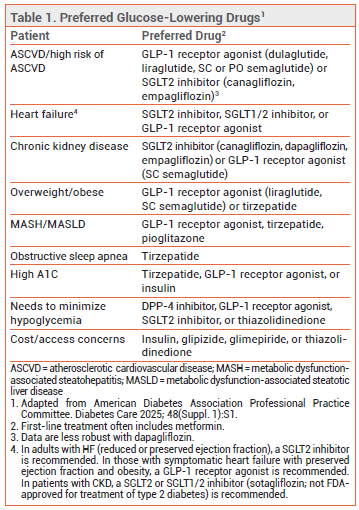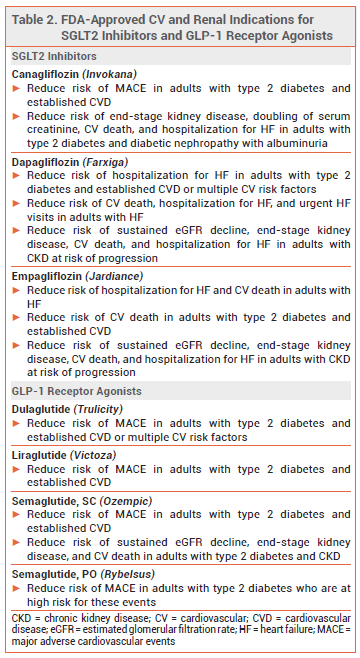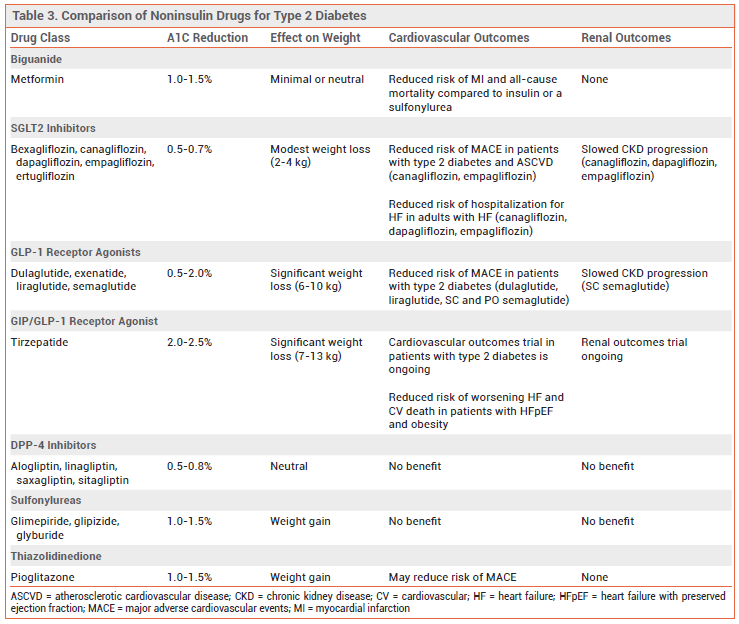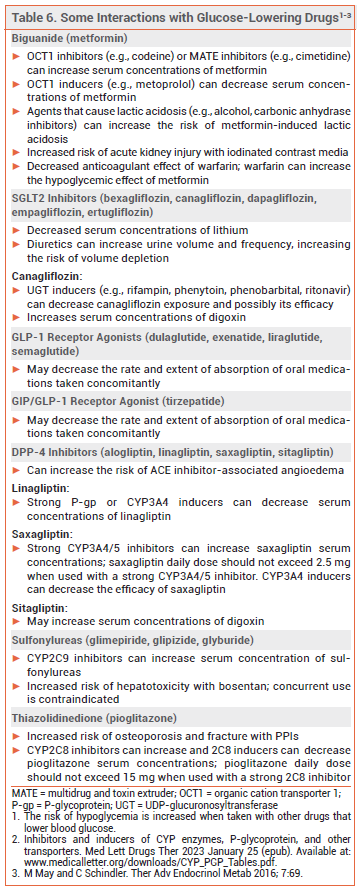ISSUE1742
- Mark Abramowicz, M.D., President has disclosed no relevant financial relationships.
- Jean-Marie Pflomm, Pharm.D., Editor in Chief has disclosed no relevant financial relationships.
- Brinda M. Shah, Pharm.D., Consulting Editor has disclosed no relevant financial relationships.
- Explain the current approach to the management of type 2 diabetes.
- Discuss the pharmacological options available for treatment of type 2 diabetes and compare them based on their efficacy, dosage and administration, drug interactions, and potential adverse effects.
- Determine the most appropriate therapy given the clinical presentation of an individual patient with type 2 diabetes.
- An A1C goal of <7% is recommended for most patients to prevent or reduce the microvascular complications of type 2 diabetes.
- Metformin is generally preferred for initial treatment, particularly in patients without obesity or CV or renal comorbidities. A GLP-1 receptor agonist or SGLT2 inhibitor may be added or substituted in patients with these comorbidities.
- Initial combination therapy can be considered in patients with A1C levels 1.5-2% above goal and in those with comorbidities for whom specific classes of drugs have additional benefits.
- GLP-1 receptor agonists and tirzepatide are especially beneficial for patients who require weight loss.
Tables
Diet, exercise, and weight loss can improve glycemic control, but most patients with type 2 diabetes eventually require glucose-lowering pharmacotherapy. An A1C goal of <7% (while minimizing hypoglycemia) is recommended for most patients to prevent or reduce the microvascular complications of diabetes (retinopathy, nephropathy, neuropathy). An A1C target of <8% may be appropriate for patients who are older, have comorbid conditions, or are at risk of serious hypoglycemia-associated adverse events.1

INITIAL TREATMENT — Metformin is generally preferred for initial treatment of type 2 diabetes, but a SGLT2 inhibitor or GLP-1 receptor agonist may be added or substituted in patients with obesity or CV or renal comorbidities. Initial combination therapy can be considered in patients with A1C levels 1.5-2% above goal and in those with comorbidities for whom specific classes of drugs have additional benefits (e.g., CVD, CKD, HF, obesity).1
Adding a Second Drug – Most patients require multiple drugs for glycemic control. The choice of a second glucose-lowering drug is generally based on A1C levels and the presence of comorbid conditions (see Table 1). When added to metformin, another oral noninsulin drug generally lowers A1C by about 0.7-1% and a GLP-1 receptor agonist or dual GIP/GLP-1 receptor agonist generally lowers it by ≥1%.
The SGLT2 inhibitors canagliflozin and empagliflozin and the GLP-1 receptor agonists dulaglutide, liraglutide, and semaglutide have reduced the risk of MACE in patients with type 2 diabetes and established CVD. Canagliflozin, dapagliflozin, empagliflozin, and SC semaglutide have improved kidney outcomes. Liraglutide, semaglutide, and the GIP/GLP-1 receptor agonist tirzepatide can produce significant weight loss in patients with overweight/obesity. SGLT2 inhibitors have been more effective than GLP-1 receptor agonists in preventing hospitalization for HF.
METFORMIN — The biguanide metformin reduces hepatic gluconeogenesis. It may also reduce intestinal absorption of glucose and (to a lesser extent) increase peripheral glucose uptake. Metformin is generally preferred for initial treatment of type 2 diabetes, particularly in patients without CV or renal comorbidities or obesity. It generally reduces A1C by 1-1.5%, causes minimal weight loss or is weight-neutral, and does not cause hypoglycemia. In a study that included 17 systematic reviews with meta-analyses, use of metformin was associated with a lower risk of all-cause mortality and CV mortality compared to use of a sulfonylurea or insulin.2
Adverse Effects – Metformin can cause GI adverse effects (metallic taste, nausea, diarrhea, abdominal pain), vitamin B12 deficiency, and (rarely) lactic acidosis. Slow titration of the dose and taking the drug with food can minimize GI adverse effects.
Metformin is contraindicated for use in patients with an eGFR <30 mL/min/1.73 m2, and starting the drug in patients with an eGFR ≤45 mL/min/1.73 m2 is generally not recommended.3
SGLT2 INHIBITORS — SGLT2 inhibitors decrease renal glucose reabsorption and increase urinary glucose excretion, reducing fasting and postprandial blood glucose levels without causing hypoglycemia. They generally reduce A1C by 0.5-0.7% in patients with adequate renal function. Added to standard treatment, canagliflozin and empagliflozin have reduced the risk of MACE in patients with type 2 diabetes and established CVD.4,5 Canagliflozin, empagliflozin, and dapagliflozin are FDA-approved to reduce the risk of hospitalization for HF and slow progression of CKD.4,6-10 In patients with CKD, empagliflozin has reduced the risk of kidney disease progression, end-stage kidney disease, and CV death for up to 12 months after it was discontinued.11 Ertugliflozin and bexagliflozin have not been shown to reduce the risk of MACE, and they are not approved by the FDA for any CV or renal indications.12,13
Adverse Effects – SGLT2 inhibitors can increase the risk of genital mycotic infection, bacterial urinary tract infection, volume depletion, acute kidney injury, and hypotension. Ketoacidosis can occur rarely. Increased risks of lower limb amputations (canagliflozin, ertugliflozin), falls, bone fractures (canagliflozin), urosepsis, pyelonephritis, and Fournier's gangrene have been reported.
INCRETIN-BASED DRUGS — GLP-1 receptor agonists potentiate glucose-dependent secretion of insulin, suppress glucagon secretion, slow gastric emptying, and promote satiety without causing hypoglycemia. They generally reduce A1C by 0.5-2%; reductions appear to be greatest with semaglutide and tirzepatide.
Dulaglutide, liraglutide, and SC and PO semaglutide have reduced the risk of MACE in adults with established CVD, but they have not been shown to reduce hospitalization for HF. SC semaglutide has slowed progression of CKD in patients with type 2 diabetes.14-22 In patients with type 2 diabetes and peripheral artery disease with intermittent claudication, SC semaglutide reduced progression of peripheral artery disease by 54% independent of baseline glycemic control and body mass index (BMI).23
Wegovy, a subcutaneously injected formulation of semaglutide, is FDA-approved for chronic weight management in patients ≥12 years old, to reduce the risk of MACE in adults with established CVD and obesity/overweight, and for treatment of noncirrhotic metabolic dysfunction-associated steatohepatitis (MASH) with moderate to advanced hepatic fibrosis in adults.24,25 Liraglutide is FDA-approved as Saxenda for chronic weight management in patients ≥12 years old.
Tirzepatide is a subcutaneously injected incretin peptide hormone with activity at GIP and GLP-1 receptors. In clinical trials in patients with type 2 diabetes, tirzepatide reduced A1C (2-2.5%) and body weight (7-13 kg) more than SC semaglutide, insulin degludec, and insulin glargine.26 A cardiovascular outcomes trial (SURPASS-CVOT) evaluating the effect of tirzepatide on MACE in patients with type 2 diabetes is expected to be published soon.27 Kidney outcomes trials with tirzepatide are ongoing.
Tirzepatide is also FDA-approved as Zepbound for chronic weight management in adults and for treatment of moderate to severe obstructive sleep apnea (OSA) in adults with obesity.28,29
Semaglutide vs Tirzepatide – In two large systematic reviews with meta-analyses in patients with type 2 diabetes, tirzepatide was more effective in reducing A1C and weight than SC semaglutide. The incidence of GI adverse events was about the same with both drugs.30,31
Adverse Effects – Incretin-based drugs commonly cause GI adverse effects (nausea, vomiting, diarrhea, constipation); slow titration of the dose can improve tolerability. Acute pancreatitis, gall bladder disease including cholelithiasis, and renal failure (possibly due to dehydration), and increases in heart rate have been reported. Hypoglycemia occurs rarely, predominantly with concurrent use of other glucose-lowering drugs. GLP-1 receptor agonists have been associated with reductions in muscle mass and nutritional deficiencies.32
GLP-1 receptor agonists have been associated with an increased risk of gastroesophageal reflux disease (GERD) and its complications, including Barrett's esophagus.33 The labels of all GLP-1 receptor agonists and tirzepatide include postmarketing reports of ileus associated with their use.34 Pulmonary aspiration has been reported rarely with use of these drugs in patients undergoing procedures requiring general anesthesia or deep sedation who had residual gastric contents despite preoperative fasting.35
In patients with type 2 diabetes, use of GLP-1 receptor agonists and tirzepatide have been associated with an increased risk of ocular complications including diabetic retinopathy, nonarteritic anterior ischemic optic neuropathy (NAION), and neovascular age-related macular degeneration (AMD).36-38
The labels of all GLP-1 receptor agonists and tirzepatide include a boxed warning about a risk of thyroid C-cell tumors (based on animal data; no corroborating human data). These drugs are contraindicated for use in patients with a personal or family history of medullary thyroid carcinoma and in those with multiple endocrine neoplasia syndrome type 2.
DPP-4 INHIBITORS — The DPP-4 inhibitors alogliptin, linagliptin, saxagliptin, and sitagliptin potentiate glucose-dependent secretion of insulin and suppress glucagon secretion. They typically reduce A1C by 0.5-0.8%. In large randomized controlled trials in patients with type 2 diabetes who have established CVD or are at high risk for CVD, DPP-4 inhibitors have not increased or decreased the risk of MACE, hospitalization for HF, or progression of CKD.39
Adverse Effects – DPP-4 inhibitors are generally well tolerated. Joint pain and myalgia can occur. They can increase the risk of pancreatitis and hepatic dysfunction/hepatitis. Worsening of HF can occur with use of alogliptin or saxagliptin.
SULFONYLUREAS — Sulfonylureas interact with ATP-sensitive potassium channels in the beta-cell membrane to increase secretion of insulin independent of nutrient intake, which can often cause hypoglycemia. The sulfonylureas glimepiride, glipizide, and glyburide reduce A1C by 1-1.5%. Their effectiveness in reducing A1C, ease of use, and low cost led to their widespread use as second-line agents, but they can cause weight gain and hypoglycemia and have not been shown to have a beneficial effect on CV or renal outcomes.40,41 Because of its adverse effects, many expert clinicians recommend against use of glyburide.
Adverse Effects – Hypoglycemia is common with use of a sulfonylurea, especially glyburide. Weight gain can occur.
THIAZOLIDINEDIONES — Pioglitazone and rosiglitazone (not currently available in the US) increase insulin sensitivity in adipose tissue, skeletal muscle, and the liver and decrease hepatic glucose production. They reduce A1C by 1-1.5%.
Adverse Effects – Thiazolidinediones cause weight gain and fluid retention/peripheral edema. They can increase the risk of HF (use in patients with NYHA class III or IV HF is contraindicated), bone fractures, bladder cancer, and macular edema.42
MEGLITINIDES — Nateglinide and repaglinide, although structurally different from sulfonylureas, also bind to ATP-sensitive potassium channels on beta cells and increase insulin release independent of nutrient intake. Repaglinide reduces A1C more than nateglinide (1.0% vs 0.5%). Both drugs are rapidly absorbed and cleared; plasma levels of insulin peak 30-60 minutes after each dose. They have not been shown to improve CV outcomes or reduce microvascular complications, and they can cause hypoglycemia.
ALPHA-GLUCOSIDASE INHIBITORS — Acarbose and miglitol inhibit the alpha-glucosidase enzymes that line the brush border of the small intestine, interfering with hydrolysis of carbohydrates and delaying absorption of glucose and other monosaccharides. To decrease postprandial glucose concentrations, acarbose and miglitol should be taken with each meal. They are minimally effective in reducing A1C and frequently cause GI adverse effects such as bloating and flatulence.
PREGNANCY AND LACTATION — Insulin is the drug of choice for treatment of type 2 diabetes in pregnant women. Insufficient data are available on the long-term safety of other glucose-lowering drugs during pregnancy.
Insulin and metformin are generally considered safe for use while breastfeeding. Data on the use of SGLT2 inhibitors, GLP-1 receptor agonists, tirzepatide, or DPP-4 inhibitors in lactating women or their effects on the breastfed infant or milk production are limited.
Additional Content Available:
Comparison Chart: Sodium-Glucose Cotransporter 2 (SGLT2) Inhibitors
Comparison Chart: GLP-1 and GIP/GLP-1 Receptor Agonists for Type 2 Diabetes
- American Diabetes Association Professional Practice Committee. Introduction and methodology: standards of care in diabetes – 2025. Diabetes Care 2025; 48(Suppl. 1):S1. doi:10.2337/dc25-SINT
- M Bahardoust et al. Effect of metformin (vs. placebo or sulfonylurea) on all-cause and cardiovascular mortality and incident cardiovascular events in patients with diabetes: an umbrella review of systematic reviews with meta-analysis. J Diabetes Metab Disord 2024; 23:27. doi:10.1007/s40200-023-01309-y
- FDA Drug Safety Communication: FDA revises warnings regarding use of the diabetes medicine metformin in certain patients with reduced kidney function. April 2017. Available at: https://bit.ly/3SdEFRN. Accessed November 6, 2025.
- B Neal et al. Canagliflozin and cardiovascular and renal events in type 2 diabetes. N Engl J Med 2017; 377:644. doi:10.1056/nejmoa1611925
- B Zinman et al. Empagliflozin, cardiovascular outcomes, and mortality in type 2 diabetes. N Engl J Med 2015; 373:2117. doi:10.1056/nejmoa1504720
- V Perkovic et al. Canagliflozin and renal outcomes in type 2 diabetes and nephropathy. N Engl J Med 2019; 380:2295. doi:10.1056/nejmoa1811744
- SD Wiviott et al. Dapagliflozin and cardiovascular outcomes in type 2 diabetes. N Engl J Med 2019; 380:347. doi:10.1056/nejmoa1812389
- SD Solomon et al. Dapagliflozin in heart failure with mildly reduced or preserved ejection fraction. N Engl J Med 2022; 387:1089. doi:10.1056/nejmoa2206286
- HJL Heerspink et al. Dapagliflozin in patients with chronic kidney disease. N Engl J Med 2020; 383:1436. doi:10.1056/nejmoa2024816
- M Packer et al. Cardiovascular and renal outcomes with empagliflozin in heart failure. N Engl J Med 2020; 383:1413. doi:10.1056/nejmoa2022190
- The EMPA-KIDNEY Collaborative Group. Long-term effects of empagliflozin in patients with chronic kidney disease. N Engl J Med 2025; 392:777. doi:10.1056/nejmoa2409183
- CP Cannon et al. Cardiovascular outcomes with ertugliflozin in type 2 diabetes. N Engl J Med 2020; 383:1425. doi:10.1056/nejmoa2004967
- Bexagliflozin (Brenzavvy) – a fifth SGLT2 inhibitor for type 2 diabetes. Med Lett Drugs Ther 2023; 65:130.
- MN Kosiborod et al. Semaglutide in patients with obesityrelated heart failure and type 2 diabetes. N Engl J Med 2024; 390:1394. doi:10.1056/nejmoa2313917
- HC Gerstein et al. Dulaglutide and cardiovascular outcomes in type 2 diabetes (REWIND): a double-blind, randomised placebo-controlled trial. Lancet 2019; 394:121. doi:10.1016/s0140-6736(19)31149-3
- HC Gerstein et al. Dulaglutide and renal outcomes in type 2 diabetes: an exploratory analysis of the REWIND randomised, placebo-controlled trial. Lancet 2019; 394:131. doi:10.1016/s0140-6736(19)31150-x
- SP Marso et al. Liraglutide and cardiovascular outcomes in type 2 diabetes. N Engl J Med 2016; 375:311. doi:10.1056/nejmoa1603827
- JFE Mann et al. Liraglutide and renal outcomes in type 2 diabetes. N Engl J Med 2017; 377:839. doi:10.1056/nejmoa1616011
- SP Marso et al. Semaglutide and cardiovascular outcomes in patients with type 2 diabetes. N Engl J Med 2016; 375:1834. doi:10.1056/nejmoa1607141
- Semaglutide (Ozempic) – another injectable GLP-1 receptor agonist for type 2 diabetes. Med Lett Drugs Ther 2018; 60:19.
- V Perkovic et al. Effects of semaglutide on chronic kidney disease in patients with type 2 diabetes. N Engl J Med 2024; 391:109. doi:10.1056/nejmoa2403347
- DK McGuire et al. Oral semaglutide and cardiovascular outcomes in high-risk type 2 diabetes. N Engl J Med 2025; 392:2001. doi:10.1056/nejmoa2501006
- MP Bonaca et al. Semaglutide and walking capacity in people with symptomatic peripheral artery disease and type 2 diabetes (STRIDE): a phase 3b, double-blind, randomised, placebo-controlled trial. Lancet 2025; 405:1580. doi:10.1016/s0140-6736(25)00509-4
- A new indication for semaglutide (Wegovy). Med Lett Drugs Ther 2024; 66:66.
- Semaglutide (Wegovy) for MASH. Med Lett Drugs Ther 2025; 67:161.
- Tirzepatide (Mounjaro) for type 2 diabetes. Med Lett Drugs Ther 2022; 64:105.
- SJ Nicholls et al. Comparison of tirzepatide and dulaglutide on major adverse cardiovascular events in participants with type 2 diabetes and atherosclerotic cardiovascular disease: SURPASS-CVOT design and baseline characteristics. Am Heart J 2024; 267:1. doi:10.1016/j.ahj.2023.09.007
- Tirzepatide (Zepbound) for chronic weight management. Med Lett Drugs Ther 2023; 65:205.
- Tirzepatide (Zepbound) for obstructive sleep apnea. Med Lett Drugs Ther 2025; 67:29.
- H Yao et al. Comparative effectiveness of GLP-1 receptor agonists on glycaemic control, body weight, and lipid profile for type 2 diabetes: systematic review and network meta-analysis. BMJ 2024; 384:e076410. doi:10.1136/bmj-2023-076410
- T Karagiannis et al. Subcutaneously administered tirzepatide vs semaglutide for adults with type 2 diabetes: a systematic review and network meta-analysis of randomised controlled trials. Diabetologia 2024; 67:1206. doi:10.1007/s00125-024-06144-1
- W Scott Butsch et al. Nutritional deficiencies and muscle loss in adults with type 2 diabetes using GLP-1 receptor agonists: a retrospective observational study. Obes Pillars 2025; 15:100186. doi:10.1016/j.obpill.2025.100186
- Y Noh et al. Glucagon-like peptide-1 receptor agonists and risk for gastroesophageal reflux disease in patients with type 2 diabetes: a population-based cohort study. Ann Intern Med 2025; 178:1268. doi:10.7326/annals-24-03420
- In brief: GI effects of GLP-1 receptor agonists. Med Lett Drugs Ther 2023; 65:191.
- In brief: New FDA warning on pulmonary aspiration with GLP-1 receptor agonists. Med Lett Drugs Ther 2024; 66:201.
- American Diabetes Association Professional Practice Committee. 12. Retinopathy, neuropathy, and foot care: standards of care in diabetes-2025. Diabetes Care 2025; 48(Suppl 1):S252. doi:10.2337/dc25-S012
- CX Cai et al. Semaglutide and nonarteritic anterior ischemic optic neuropathy. JAMA Ophthalmol 2025; 143:304. doi:10.1001/jamaophthalmol.2024.6555
- J Rosenstock et al. Effect of linagliptin vs placebo on major cardiovascular events in adults with type 2 diabetes and high cardiovascular and renal risk: the CARMELINA randomized clinical trial. JAMA 2019; 321:69. doi:10.1001/jama.2018.18269
- R Shor et al. Glucagon-like peptide-1 receptor agonists and risk of neovascular age-related macular degeneration. JAMA Ophthalmol 2025; 143:587. doi:10.1001/jamaophthalmol.2025.1455
- KB Filion et al. Sulfonylureas as initial treatment for type 2 diabetes and the risk of adverse cardiovascular events: a population-based cohort study. Br J Clin Pharmacol 2019; 85:2378. doi:10.1111/bcp.14056
- A Douros et al. Sulfonylureas as second line drugs in type 2 diabetes and the risk of cardiovascular and hypoglycaemic events: population-based cohort study. BMJ 2018; 362:k2693. doi:10.1136/bmj.k2693
- AV Hernandez et al. Thiazolidinediones and risk of heart failure in patients with or at high risk of type 2 diabetes mellitus: a meta-analysis and meta-regression analysis of placebo-controlled randomized clinical trials. Am J Cardiovasc Drugs 2011; 11:115. doi:10.2165/11587580-000000000-00000
The Medical Letter, Inc. does not warrant that all the material in this publication is accurate and complete in every respect. The Medical Letter, Inc. and its editors shall not be held responsible for any damage resulting from any error, inaccuracy, or omission.






